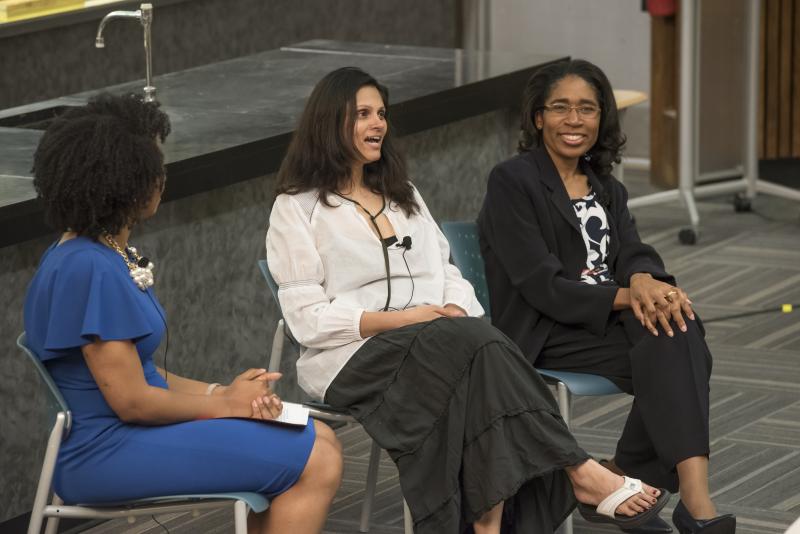
On a busy day early in her career in her hepatology clinic, Carla Brady, MD, associate professor of medicine (Gastroenterology), entered the exam room to meet a new patient referred to her for Hepatitis C management.
The patient, a young mother who was pregnant with her second child, pulled out her cell phone and showed Brady a photo of her 3-year-old child.
“She said to me, ‘I want to show you a picture so that I can give you a face to put with the reason as to why I’m sitting here in front of you in the clinic,” said Brady. “I thought to myself, ‘this is validation for what I really, really want to do and that’s taking care of pregnant women with liver disorders.’”
With that inspiration, Brady created a clinic that focuses on providing specialized care for women like her patient. That moment also influenced her decision to focus her research interests on liver disease from a woman’s health perspective.
(Top photo: Dr. Nimmi Ramanujam, Biomedical Engineering Duke Professor, and Carla Brady, MD, associate professor of medicine (Gastroenterology), during the Q&A discussion with Johnna Frierson. Photo Courtesy of Duke Pratt School of Engineering/Photographer Les Todd)
While there is research data and established guidelines for treating most patients for various liver diseases, research data for managing liver diseases in pregnant women are limited, Brady told a gathering of students, trainees, and students at the Pratt School of Engineering’s “Women of Inspiration: How the Power of One Can Impact Our World,” in March.
Compared to its past therapies, the newest therapies for Hepatitis C have a high success rate with minimal side effects. However, the safety of these new drugs in pregnancy is not known. There are not enough data to evaluate the risks of current Hepatitis C therapies in pregnancy or breastfeeding mothers and their babies.
Some women with liver disease, and those who have undergone liver transplantation, are counseled against getting pregnant, Brady said.
But Brady advises that for some patients with liver disease pregnancy is possible.
“It becomes very important to be armed with the appropriate level of knowledge and data to provide focused and specialized care for a very deserving patient population,” she said.
To ensure this patient population isn’t underserved, Brady and colleagues from other divisions at Duke formed the Obstetric Medicine Group (OMG) to provide specialized multidisciplinary care to pregnant women.
(Left Photo: Dr. Brady during her presentation at Duke Pratt's "Women of Inspiration: How the Power of One Can Impact Our World.” Courtesy of Duke Pratt/Photographer Les Todd)
The group meets regularly to talk about cases, plan and coordinate clinical care, and discuss possible education and research initiatives.
“We’re hopeful that what we do someday will become the standard approach to how providers will provide medical care to pregnant women,” she said.
Remembering Women's Contributions in STEM
Brady's patient's story held significance because it related to another woman’s story told at the event—the story of Henrietta Lacks. The event screened the movie “The Immortal Life of Henrietta Lacks,” which is based on best-selling book of the same title by Rebecca Skloot.
Lacks was an African-American mother of five children whose cervical cancer cells were cultivated without her or her family's permission or knowledge in 1951 at John Hopkins Hospital. Now known as HeLa cells, Lacks’ cells became the first immortalized, rapidly reproducing cell line in history. Her cells serves as a vital resource in medical and scientific research. HeLa cells are sold globally by the billions.
For years after Lack's death, virtually nothing was known about the origin of HeLa Cells. Then in 1976, the Detroit Free Press made the first HeLa cells connection to Lacks, even though she was still referred to as “Helen Lane.”
“Henrietta Lacks has probably made one of the greatest contributions to medical and modern science,” said Brady. “She did so unknowingly and without any credit due to her until long after her death.”
Brady highlighted other women’s historical contributions to Science, Technology, Engineering, and Mathematics (STEM) such as Rebecca Lee Crumpler (first African American female doctor), and Susan La Flesche Picotte (first Native American female doctor), and Helen Rodríguez Trías (first Latina president for American Public Health Association).
“A little bit of uncertainty is probably a good thing because if you can push pass that, then you’re that much stronger the next time around. It’s going to help you with the next thing you’re going to do along the way.”
- Carla Brady, MD
In her presentation Brady noted the quote by Trías: “We cannot achieve a healthier us without achieving a healthier, more equitable health care system, and ultimately, a more equitable society."
Brady said that through her experiences in medicine as a woman and as an African-American, she understands the pressure of ensuring appropriate recognition among peers, but such pressure also sparks willpower from within. With the right intentions, it can be the encouragement someone needs to succeed.
“I had to push myself to a little bit because I never wanted to be mistaken as not knowing, not being smart enough, or not having a thought about something,” said Brady. “I had to make sure that I worked hard in that regard. Sometimes, I think that there’s internalized pressure that goes on, but I think if you use it for the right thing, it can be a personal inspiration for you.”
This sentiment also relates to the “imposter syndrome,” which is when someone doubts or questions their abilities despite reaching high levels of success. While Brady has achieved that kind of success in her career (such as being elected to the Nominating Committee for American Association for the Study of Liver Diseases in 2017), she is not a stranger to the “imposter syndrome.”
“I still feel it…The way that I try to think about things like that is if I’m feeling that way, there’s probably someone else out there who is feeling that way too,” Brady said. “A little bit of uncertainty is probably a good thing because if you can push pass that, then you’re that much stronger the next time around. It’s going to help you with the next thing you’re going to do along the way.”
Finding harmony between home and work life
Without a doubt, Brady said having a STEM career is a busy lifestyle. Balancing life at home and life at work can be challenging. Sometimes, there is a looming guilt that manifests itself when she misses seeing her children off to bed or when she leaves for work early in the morning without eating breakfast with them.
“I think as women, we have the capability to do it all. What you have to recognize is that you can’t do it all at one time. Every single day, you have to establish what your priorities are going to be for that day,” she said. “If there are times when you can spend breakfast with the kids or spend a couple hours being at home with them instead doing something after work, I think that it makes a difference...I think children remember more than what we give them credit for.”
After Brady had her first child, she and a senior Duke faculty member had a conversation about motherhood that impacted how she raised her children as a parent in the STEM field.
“She said to me ‘Carla, when it comes to education and taking care of your children, you have to recognize that there are no do-overs. You get one time to do this and do this well,’” Brady said. “That resonated with me. I always think about that and keep it in the forefront of what I do...You don’t get do-overs with your kids. They’re going to go through their childhood one time so you really want to try to be there for them as much as you can.”
This story was written by Tia Mitchell, communications intern for the Department of Medicine.